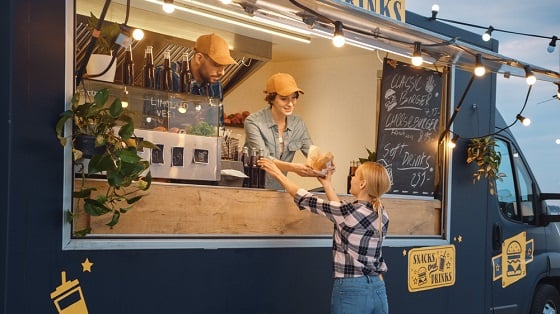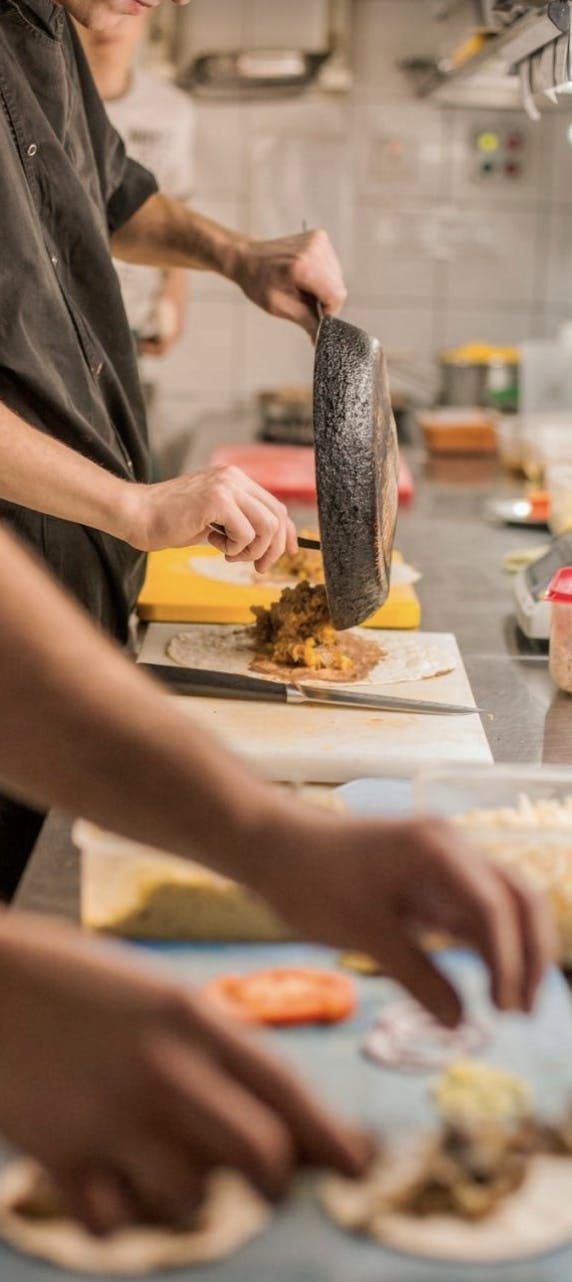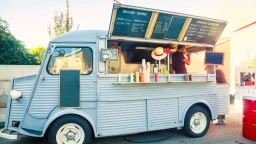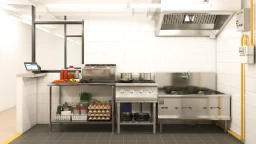Food Truck vs Restaurant vs Ghost Kitchen: Which is Better?
Table of Contents
CloudKitchens
How many tacos can be delivered from a 1000sqft restaurant?
The same amount as a 200sqft ghost kitchen.

You’ve finally done it—you’ve mastered your menu. After iterating your recipes, you’ve dished out the best ones to family and friends, eagerly awaiting authentic praise.
You’ve done the work. All that’s left is setting the table.
Deciding where you will serve your best dishes is a defining step in making your restaurant business dreams a reality. The choice between a food truck vs. a restaurant (or ghost kitchen) is all that stands between you and your future happy, full customers.
But which of these types of restaurant concepts is the better business plan? Only you can determine that—with these key considerations.
| Factors | Food Truck | Restaurant | Ghost Kitchen |
|---|---|---|---|
| Capital | Mid-high | High | Low-mid |
| Staff | Low | High | Low |
| Flexibility | Low-mid | Low | High |
| Equipment requirement | Mid | High | Mid |
| Order size and revenue per customer | Low-mid | Mid-high | Low-mid |
Part 1: Food trucks
Food trucks are restaurants that allow you to prepare, cook, and serve food entirely from a moving vehicle. They’re equipped with electricity, mobile kitchen equipment, and point-of-sale technology to put your entire operation on wheels.
For a restaurant concept that’s more casual than fine dining and doesn’t require sit-down table space or large service staff, food truck ideas are a viable option.
Capital
When comparing food truck vs. restaurant costs, food trucks are slightly less expensive than restaurants. Food trucks can cost anywhere from $50,000 to over $100,000 between initial start-up and ongoing operation costs.
When learning how to start a food truck, you’ll learn that there are costs involving:
- Renting or buying the initial truck or vehicle
- City and state permits that allow you to pop up and serve your food
- Kitchen equipment, supplies, and inventory for the truck
- Licenses for food safety, vehicle requirements, and zoning
- Vehicle maintenance, fuel, and up-keep of power generators
- Employee salaries, bonuses, and tax-adjacent costs
Staff
Speaking of employees, one benefit to a food truck business is that they typically don’t require more than a handful of staff members. (After all, the truck won’t fit many more.)
Typically, to properly staff a food truck for a day’s worth of serving food, you’ll want to prepare 1–2 line cooks, 1 packaging and expediting staff member, and 1 team member to manage the point-of-sale engagements and payments. And, of course, you’ll need at least one staff member certified to drive the vehicle—although this employee can double up on responsibilities.
Flexibility
A food truck is one of the most flexible forms of restaurants available today. Its flexibility is perhaps the number one reason why its prevalence has grown almost 8% in the last 5 years in the US alone. A food truck’s ability to open at different locations frees it from sleepy locations, harsh rental fees, and demanding city requirements.
With a food truck, you can:
- Serve your street food virtually anywhere within driving distance
- Forego the need to design and decorate a sit-in space
- Expand your food establishment’s presence to new eaters every day
- More closely control sanitation standards within your space
Equipment
Think about the last commercial kitchen you saw or worked in. Scale that down to a 20% size, and you’ve got the vision for your food truck cooking space.
Food truck equipment must entirely embody the meaning of space efficiency. Where a commercial kitchen can sprawl out comfortably with stainless steel as far as the eye can see, a food truck’s mobile kitchen only has room for one commercial-sized grill top.
That said, food trucks still require all of the essential equipment needed to operate a restaurant at full capacity. You’ll need:
- Cooking and refrigerating equipment
- Warming and holding equipment
- Food preparation equipment
- Serving and packaging supplies
- Cleaning supplies
- A point-of-sale computer system
Order size and revenue per customer
When the grills are wiped clean, the tips are counted, and the generator has powered down, how does the final revenue of a food truck compare to a restaurant or ghost kitchen business model?
The average total sales (before expenses) of food trucks in the US is between $20,000 to $40,000 per month. When a food truck is profitable, its monthly expenses average around 85% of its monthly sales. If a food truck serves 100 people per day, after expenses, the revenue comes out to about $2 per customer.
Part 2: Traditional restaurants
Traditional restaurant operations are also known as “brick and mortar” restaurants, or a physical building in which an established restaurant opens to, cooks for, and serves the customer base.
Traditional restaurants favor food entrepreneurs who want to create an atmosphere around their cuisine. Your food becomes an entire mood, shaping the dining room’s color scheme, the corresponding cocktail menu, and the wait staff’s uniforms.
Capital
Traditional restaurants are by far the most expensive to start up and operate. An entire building is a lot more space to furnish, equip, and maintain compared to a small truck.
A traditional restaurant can cost anywhere from $180,000 to $800,000 to start up. To keep the lights on, there are also rent or mortgage payments, employee salaries, food costs, utilities, marketing, and other miscellaneous expenses that can range anywhere from $30,000 to $100,000 per month.
To venture into brick-and-mortar restaurant ownership, plan for these costs:
- Land and building ownership or rental
- Interior design and building renovations
- Kitchen equipment and supplies
- City permits and food-safety licenses
- Point-of-sale software and equipment
- Employee salaries and benefits
Staff
Depending on the size of the regular restaurant, traditional eateries require more employees than a food truck or ghost kitchen to keep the place running smoothly.
Enter your mind’s eye of the restaurant you most recently dined in. Look around the room: who is running the show? Restaurants need people to cook and serve the food (and perhaps pour the second glass of wine). They also need hosts to seat the guests, managers to oversee the operation, and bartenders to shake the cocktails to icy perfection.
Flexibility
Traditional restaurants offer less flexibility compared to food trucks and ghost kitchens. For one, they’re not transportable. Restaurants are more tightly bound to the location they choose as they’re tied to rental agreements or mortgages.
That said, if you’re a future restaurant owner who wants to lay a solid stake in the ground and become a part of a specific, loyal community, a restaurant may be a fair fit.
Equipment
Compared to a food truck, the back of the house in a restaurant has much more space—and many more plates—to fill. Traditional restaurants need equipment to cook food and store it in health-safe conditions while creating enough space for their kitchen masters to work.
A regular restaurant kitchen, at minimum, will need:
- Cooking equipment like grill tops and commercial ovens
- Industrial-sized refrigeration and freezer capacity
- Small kitchen appliances like blenders and slicers
- Cutlery and kitchen utensils to slice, dice, and chop
- Serving equipment and cleaning supplies
Order size and revenue per customer
The revenue earned in a restaurant varies depending on the location and size of the establishment. However, on average in the US, restaurants report earning about $1,350 per day after expenses. The average transaction averages around $27 per customer.
This means that, for restaurateurs with a hefty amount of capital saved up and the means to run an operation at a large scale, an average annual revenue of about $486,000 is possible.
Part 3: Virtual restaurants (aka ghost kitchens)
Ghost kitchens are the lesser-known heroes in the list of burgeoning dining spaces. Ghost kitchens enable chefs to serve their cuisine out of a fully-equipped kitchen. They cater exclusively to pick-up and delivery customers by interacting with customers online.
Ghost kitchens are a rapidly growing third space that mutually benefits the restaurateur and the consumer. The owner receives a ready-to-cook-in kitchen in a favorable location. And the consumer gets the chance to explore exciting, new cuisine from the comfort of home.
Capital
The start-up costs of a ghost kitchen are lower as less equipment is needed to get started. Though estimations are constantly changing as more ghost kitchens pop up, their estimated start-up cost is somewhere between $20,000 and $60,000.
Staff
A ghost kitchen also eliminates the need for a full-fledged staff: no servers, no managers, and no hosts required. The staffing of a ghost kitchen is similar, or even smaller than the size of a food truck.
As ghost kitchens are exclusively fulfilling take-out orders, a standard ghost kitchen requires 1–2 line cooks and 1–2 people to package and garnish orders. Because the point-of-sale system is digitized and automated, this duty can typically be carried out by the packaging team member.
Flexibility
A virtual kitchen or ghost kitchen may not exist on four wheels, but it does provide more flexibility than a traditional restaurant. For one, an owner can rent and manage the exact kitchen size that suits their needs—and pay accordingly.
Additionally, a ghost kitchen offers:
- A wider range of customers due to digital-first positioning
- Contracts are shorter and more flexible than typical rental leases
- The freedom to change your menu whenever you’d like
Equipment
The equipment required for a ghost kitchen is akin to a ghost itself: virtually invisible. A ghost kitchen is a premium-grade commercial kitchen equipped with all of the cooking, refrigeration, and preparation equipment a chef could ask for.
Order size and revenue per customer
Thanks to skipping egregious start-up costs seen in traditional restaurant settings, ghost kitchens help restaurant owners become profitable faster. It takes on average only about 6 months to become profitable in a ghost kitchen, earning 10% profit of an average $1M run rate.
Start your ghost kitchen operation with CloudKitchens
There are countless factors to consider when you’re opening up a restaurant—especially if it’s your first one. You want to feel confident about how your thoughtful creations fill the world’s bellies and hearts. We get it. That’s why food entrepreneurs have CloudKitchens to turn to.
CloudKitchens was created as a means to help food entrepreneurs bring their ideas to the forefront of the culinary world—because we think your creations deserve to be seen. No more exorbitant start-up costs, rigid licensing requirements, issues with restaurant inventory management, or staffing challenges. Just you, your perfect recipes, and a kitchen ready to bring them to life.
We have locations all across the United States, so whether you need commercial kitchens in San Antonio or ghost kitchens in San Diego…we’ve got you covered. Contact us today to learn more!
Book a tour of one of our kitchens today.
Explore ghost kitchen locations across the US:
- Ghost kitchens in San Francisco
- Ghost kitchens in LA
- Ghost kitchens in NYC
- Ghost Kitchens in Toronto
- Ghost Kitchens in Atlanta
- Ghost Kitchens in Dallas
- Ghost Kitchens in Chicago
- Ghost Kitchens in Denver
- Ghost Kitchens in Miami
| DISCLAIMER: This information is provided for general informational purposes only and the content does not constitute an endorsement. CloudKitchens does not warrant the accuracy or completeness of any information, text, images/graphics, links, or other content contained within the blog content. We recommend that you consult with financial, legal, and business professionals for advice specific to your situation. |
Sources:
Square. Here Are Need-To-Know Food Truck. https://squareup.com/us/en/townsquare/food-truck-cost
IBIS World. Food Trucks in the US – Market Size 2005–2028. https://www.ibisworld.com/industry-statistics/market-size/food-trucks-united-states/
Webstaurant Store. Food Truck Equipment Checklist. https://www.webstaurantstore.com/article/398/food-truck-equipment-list.html
Toast. How Much Do Food Trucks Make? https://pos.toasttab.com/blog/on-the-line/how-much-do-food-trucks-make
Webstaurant Store. How Much Does It Cost to Start a Restaurant? https://www.webstaurantstore.com/article/517/how-much-does-it-cost-to-open-a-restaurant.html
Sage. How much does it cost to open a restaurant? https://www.sage.com/en-us/accounting-software/startup-costs/restaurant/
Toast. Essential Restaurant Kitchen Equipment: The Ultimate Checklist. https://pos.toasttab.com/blog/on-the-line/restaurant-equipment
EatPallet. How Much Do Restaurants Make In A Day? Solved (2022) https://eatpallet.com/how-much-do-restaurants-make-in-a-day/
Toast. How Much Does it Cost to Open a Ghost Kitchen? https://pos.toasttab.com/blog/on-the-line/how-much-does-it-cost-to-open-a-ghost-kitchen
CloudKitchens. Ghost Kitchens. https://cloudkitchens.com/
More insights & stories
There’s more where that came from.
Get in the know and check out our additional insights





